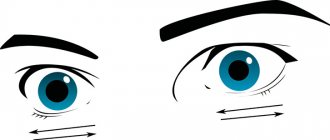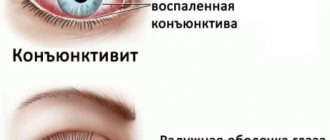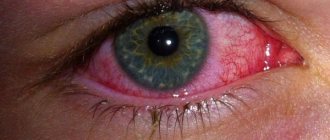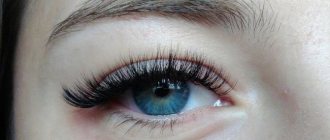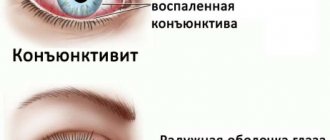Headache and red eyes - causes, treatment
Many people complain of red eyes and headaches. Indeed, this pair of symptoms occurs quite often. Should I start worrying? Doctors recommend paying attention to the frequency of such pathological manifestations; if changes in the color of proteins and migraines appear frequently and for no apparent reason, then you need to seek help from specialists at a medical institution.
Sources of unpleasant symptoms
First of all, you need to figure out why headaches and red eyes appear. The reasons for the deterioration of a person’s condition are obvious - a jump in blood pressure, which negatively affects the blood vessels. Normally, the capillaries are practically invisible, but under the influence of various irritants they swell and cause obvious discomfort. Let's look at the common causes of this pathology.
Allergies and external irritants
Individual intolerance to certain substances (dust, wool, pollen, chemical fumes) can provoke a sharp deterioration in health.
An allergic reaction often includes red eyes, profuse nasal discharge and a severe headache.
The most unpleasant thing is that, in addition to obvious irritants, trivial cigarette smoke, smog, and even cold can cause an incorrect immune response.
This condition can be combated with the help of special antihistamines, the use of simple protective devices (masks) and avoidance of contact with a possible irritant. Many people share their experience and write that they forgot about red eyes and headaches after preventive vaccination.
Overexertion and lack of rest
Modern people spend a lot of time at the computer, using various gadgets (smartphones, tablets). Of course, constant strain on your eyesight is not beneficial. Signs of fatigue include the appearance of dryness, changes in the color of the whites of the eyes (red eyes), heaviness in the head, pain, confusion, and drowsiness.
It is not difficult to combat this pathology:
- you need frequent breaks (you can just sit for a few minutes with your eyelids lowered);
- timely and high-quality sleep is useful (at least 6-8 hours a day);
- The use of special drops is allowed (Oftagel, Okutiarz are popular).
It is important to understand that prolonged overexertion is fraught with a chronic increase in intraocular pressure, myopathy and other equally dangerous diseases.
Red eyes and headache are an indicator of health, so such symptoms require immediate attention.
Eye diseases
If you have ruled out relatively safe causes of eye redness, but the headache and other manifestations of the pathological condition do not go away, then you need to undergo a comprehensive examination in the hospital.
First of all, doctors check the likelihood of the occurrence and development of:
- conjunctivitis (characteristic manifestations of the disease: burning, tearfulness, swelling of the eyelids, fatigue of the visual organs);
- inflammation of the cornea (usually keratitis is of a viral or bacterial nature);
- xerophthalmia (lack of tear production causes severe irritation of the mucous membrane);
- glaucoma (the disease can be suspected by a gradual decrease in peripheral vision).
Diabetes mellitus may be the cause of headaches. Sharp fluctuations in blood sugar levels can trigger retinal clouding, migraines and other symptoms.
Hypertension and hypertension
The most common source of a complex of unpleasant signs of a pathological condition in the form of headaches and red eyes is considered to be a persistent increase in blood pressure.
Most doctors rule out this disease first. This is not difficult to do - just take measurements with a tonometer several times a day.
The normal range is considered to be between 140 (upper) and 90 (lower) mm Hg. Art.
Therapy comes down to normalizing lifestyle, changing the diet (it is important to exclude fatty, floury, spicy foods) and taking special medications that reduce blood pressure to normal levels:
- “Furosemide”, “Adelfan”, “Captopril” - fast action;
- “Cordaflex”, “Prestarium”, “Diroton” - prolonged effect;
- "Ramipril", "Hypertonium", "Atenolol" - prevention.
You can avoid migraines and red eyes by taking the preventive drug Carditonus. The drug is sold online and does not require a prescription. There are many good reviews about the medicine from buyers and doctors.
Go to the official website!
Headache red eyes
Every person suffers from headaches from time to time.
The etiology and localization of pain syndrome may be different.
You should be wary if such manifestations are accompanied by redness of the eyes.
This often occurs due to overwork. In some cases, this may indicate the presence of serious illnesses.
We recommend reading: Headache and blurred vision
Causes
The main causes of headaches, which are accompanied by redness of the eyes:
- migraines – this causes panic, fear, sensitivity to light;
- sinusitis - pain is localized not only in the sinuses, but also in the frontal part;
- neoplasms in the brain - decreased performance, memory impairment, decreased concentration;
- increased intracranial pressure - accompanied by severe pain;
- meningitis - with this disease, the membranes of the spinal cord and brain become inflamed;
- hematomas of the head - this is caused by injuries and blows.
Risk group
People who suffer from the following diseases are at risk:
- hypertension;
- frequent increase in intracranial pressure;
- diabetes;
- sarcoidosis
Such diseases are often accompanied by severe headaches. In addition, people whose activities involve working on computers are at risk.
Symptoms
Such manifestations generally indicate the presence of serious illnesses. Headache, which is accompanied by redness of the eyes, rarely occurs without a reason. In this case, the patient experiences:
- feeling of heat;
- throbbing pain of different localization;
- redness of the eyes and a feeling of heaviness;
- the face turns red;
- performance decreases;
- Sensitivity to light appears.
If such symptoms develop, you should immediately consult a doctor. A thorough examination will be required. After determining the cause of such manifestations, the doctor prescribes treatment.
Diagnostics
With such manifestations, you will need to be examined by the following specialists: a neurologist, an ophthalmologist, a therapist. Initially, a visual inspection is carried out. The doctor must examine the medical history and listen to the patient’s complaints. It is also necessary to exclude the presence of chronic diseases. For an in-depth diagnosis, the following examinations will be needed:
After receiving the results, the doctor determines the diagnosis and prescribes drug therapy.
Treatment
If you experience a sudden headache, red eyes, nausea or fever, you should immediately consult a doctor. Such signs may indicate a cold. This is the mildest disease that such symptoms may indicate. Colds can be easily cured at home. For this purpose, cold and antipyretic drugs are used.
If the temperature does not decrease and the symptoms worsen, then you should consult a specialist. Depending on the disease, drug therapy is prescribed. Homeopathic treatment is often used. Nonsteroidal anti-inflammatory drugs, analgesics, and antispasmodics are also prescribed. Self-medication is strictly not recommended.
Complications
Complications may include the development of eye diseases: cataracts, glaucoma, conjunctivitis. If the cause of the headache is not determined in time, the presence of a tumor can lead to serious consequences.
Forecast
If you consult a doctor in a timely manner, the prognosis will be favorable. If such symptoms appear due to excessive fatigue, then getting rid of them is very simple. In addition to drug therapy, preventive measures must be constantly taken.
Prevention
Prevention will help reduce the risk of developing such manifestations:
- proper and balanced nutrition (plenty of vegetables, fruits, herbs);
- long-term stress when working at a computer, requires frequent breaks and eye exercises;
- limit the development of stress, depression, emotional tension.
With timely treatment, the risk of complications is significantly reduced.
Poor vision significantly worsens the quality of life and makes it impossible to see the world as it is.
Not to mention the progression of pathologies and complete blindness.
MNTK "Eye Microsurgery" published an article on non-surgical restoration of vision up to 90%, this became possible thanks to...
Read more Was this article helpful?
Head and eye pain: what are the causes and how to treat the symptom - Izvilina
The situation when a person has a headache, and the eyes are a source of additional discomfort, is not uncommon. You should not ignore the condition or immediately begin self-therapy.
It is better to assess the full picture of the situation and seek advice from a specialist. An experienced doctor, based on one clinical picture, may suspect why attacks of headache and pain around the eyes appear simultaneously.
In most cases, anxiety symptoms can be easily relieved with simple manipulations.
Types of headaches
Physiological and pathological conditions that are accompanied by pain in the head and eyes often have additional specific symptoms. Some patients constantly have pain in a certain part of the skull, for others it is difficult to determine the localization of the symptom, for others it is difficult to even move their eyeballs.
The type of sensations, frequency and time of their occurrence, duration - all this helps the doctor when making a diagnosis. Systematic or prolonged attacks of eye pain and headache are usually accompanied by a number of striking clinical manifestations. Some of them affect the human psyche or lead to a decrease in the quality of his life.
Why does my head hurt and put pressure on my eyes?
Doctors give an impressive list of reasons. In most cases, timely initiation of treatment allows you to quickly and completely get rid of the unpleasant syndrome.
The main thing is not to delay going to the doctor, not to try to solve the problem with the help of painkillers and not to get carried away with traditional medicine without the permission of a specialist.
Overwork
Often, a mild headache pressing on the eyes turns out to be the cause of eye fatigue due to prolonged eye strain or working at the computer. It doesn't bother you so much as it distracts you from your usual activities.
In this case, blurred vision and decreased visual acuity are observed, pain is localized in the temples and back of the head. Red eyes appear dry or, on the contrary, become very watery. If you ignore the condition, it will be accompanied by general weakness, weakness, dizziness and nausea.
Migraine
The symptom occurs in one half of the head, often in the temporal region. The headache constantly hurts and radiates to the eye or bridge of the nose, sometimes a shooting type of symptom.
The disease is characterized by pulsating sensations, which are accompanied by a decrease in the quality of vision and “spots.” When moving the head and eyes, under the influence of light or strong odors, the pain intensifies.
The attack lasts from 3-4 to 72 hours and may not respond to analgesics and antispasmodics.
Tension headache
Physical and intellectual overload cause spasm of blood vessels in the brain, neck, shoulders and face. Soreness is noted in all of these areas, accompanied by a pressing sensation on the eyes. Prolonged physical or nervous tension is fraught with exacerbation of the clinical picture, the development of stagnation in the tissues and the transition of the condition to a chronic form.
Hypertonic disease
If a headache is accompanied not just by pain in the eyes, but by a bursting sensation, this indicates an increase in blood pressure. The condition is extremely dangerous, as it can cause a stroke.
With hypertension, the pressure on the eyes becomes unbearable. They seem to literally jump out of their orbits. Rest does not bring the desired relief. Hypotension is also accompanied by pain in the head, but at the same time the person’s eyes darken, and the eyelids become very heavy and one wants to cover them.
Increased intracranial pressure
Chronic increased (or decreased) intracranial pressure is accompanied by constant dull sensations with shooting in the eyes and nausea. Symptoms worsen at night or in the morning. Even after rest, patients complain of weakness, drowsiness, dizziness and fatigue. After some time, vision problems appear.
Increased intraocular pressure
The main causes of primary pathology: hypertension, colds, diabetes, cataracts and glaucoma. Ignoring headaches and discomfort in the eye area in the last two cases is fraught with blindness. Even if you have a slight bursting sensation, you should not neglect going to the doctor. Heaviness in the eyes and changes in the quality of vision indicate the progression of the disease.
A secondary increase in the indicator is typical for injuries, inflammatory diseases, and tumors. It usually acts as an additional symptom, but may be the only manifestation of the pathology. If it is painful to move your eyes and this symptom does not go away with rest, you should check your intraocular pressure and optic nerve.
Inflammatory diseases of the nose and paranasal sinuses
In some cases, lacrimation and discomfort in the eyes due to headaches complement the picture of allergic or infectious rhinitis. The symptoms are mild and disappear as the general condition improves.
Sinusitis, ethmoiditis and frontal sinusitis - inflammatory processes in the paranasal sinuses - are accompanied by severe pain in the head, especially in the forehead. They intensify when changing body position; it is unpleasant for the patient to raise his eyes upward.
Ignoring illnesses can provoke meningitis or encephalitis, and these conditions threaten human health and life.
Diseases of the eyes and paraorbital region
The appearance of pain in the head against the background of ophthalmological problems indicates the neglect of the case. Typically, such diseases begin to manifest themselves before their negative impact spreads to the central nervous system. Regular visits to the ophthalmologist for preventive purposes will reduce such risks to a minimum.
If the eyeball and head hurt, the reasons may be:
- glaucoma - due to increased intraocular pressure, headaches appear, vision decreases, and the pupil dilates. There is swelling of the eyelids and redness of the mucous membrane. The patient is uncomfortable looking at the light. In the later stages, the clinical picture is supplemented by dizziness, nausea, and vomiting;
- spasm of accommodation (false myopia) – pathological contraction of the eye muscle leads to decreased vision and eye fatigue. This is accompanied by headaches in the temples and frontal lobe, lacrimation and redness of the mucous membrane. A person complains of pain in the eyes and severe discomfort, which is difficult to relieve with improvised means;
- thrombosis of the eye - blocking a vessel with a blood clot leads to impaired blood circulation in the tissues. In the initial stages of the pathology, the patient experiences vision problems in the form of “blind” spots or a veil. Pain in the eye appears when blinking, and headaches are the result of tissue malnutrition and necrosis.
Of particular danger is an ignored or incompletely treated injury to the eyeball. If a person’s vision decreases, one eye twitches, or suffers from constant headaches or attacks, this may indicate a violation of the innervation or blood supply to certain parts of the visual apparatus. Head injuries, especially the occipital part, can lead to the same consequences.
Brain diseases
Organic tissue damage, inflammation, infection and poor circulation in the brain lead to a number of symptoms. Headaches and discomfort in the eyes are not the most informative signs against their background, but they still help to suspect certain diagnoses.
The combination of two symptoms is characteristic of such diseases:
- intracranial hematoma: the cause of the pathology in most cases is traumatic brain injury. The headache is constant and long, up to 5-7 days in a row. Painful sensations in the eyes may be accompanied by dizziness, a feeling of fullness inside the skull;
- inflammation of the meninges - arachnoiditis, pachymeningitis, leptomeningitis - pain is prolonged and painful, almost does not respond to medication. When moving, my head starts to hurt even more. It puts pressure on my eyes from the inside, I don’t want to open them.
- brain sarcoma – accompanied by local or general headache, dizziness, nausea, vomiting, weakness.
If a person has red eyes and a severe headache, do not attribute it to a cold or other “non-dangerous” illness. It is better to consult a doctor immediately and rule out brain damage. With these diseases, time is of the essence and early treatment can save lives.
Vascular lesions
Ischemic tissue damage or cerebral hemorrhage can cause the patient’s death or disability. The sooner the diagnosis is made and treatment is started, the lower the likelihood of negative irreversible consequences.
The most common cause of a combination of symptoms is:
- Aneurysm is a lingering, pulsating pain. It is usually concentrated in the frontal part of the head and radiates into the eyes. Intensifies with movement or rotation of the eyeballs;
- stroke - headache extends to the eyes and is often accompanied by blurred vision. This is accompanied by paralysis of the facial muscles on one half of the face;
- temporal arteritis – the patient’s temperature rises, nausea and weakness appear. The pain is one-sided, in the temple area, radiating to the eyes, forehead, crown. The sensation is aching or pulsating, intensified by chewing.
An unpleasant condition may have other reasons. Sometimes the problem lies in the incorrect selection of glasses or contact lenses, an allergic reaction, a purulent or inflammatory process in the head (carious teeth, gum disease). A characteristic syndrome provokes osteochondrosis - with a headache in the back of the head.
What to do if your eyes and head hurt
If unpleasant symptoms occur, you should contact specialists for help. It is recommended to start with a visit to your local physician.
Depending on the characteristics of the clinical picture, he will refer you to a neurologist, ophthalmologist, ENT specialist, or prescribe diagnostic tests. You should not try to get rid of the disease on your own.
Analgesics, NSAIDs, antispasmodics and other tablets help relieve a painful attack, but do not always act on the cause of the condition.
Eye exercises
According to statistics, the most common cause of headaches and pressure on the eyeballs is eye fatigue. Often, it is enough to give the visual organs a rest or use artificial tears to get rid of the discomfort.
A head massage and eye exercises provide a therapeutic effect. The latter are represented by a whole group of manipulations. It includes rotational movements of the eyeballs, frequent blinking of the eyelids, and fixation of the gaze on a certain point in the distance. Every 45 minutes you should take a break from work and give your eyes a rest.
ethnoscience
Non-traditional methods of combating symptoms include the use of eye compresses, physiotherapeutic approaches, and the use of medicinal drinks. If there are no contraindications such as inflammation and fever, you should take a warm bath.
When the nature of the pain is dull and weak, and not pronounced and paroxysmal, you can drink a cup of warm milk with honey or chamomile tea. This will dilate the blood vessels, relax and calm you down.
Causes of severe headache and eye pain
Headache bothers many people, but not everyone thinks about what reasons lead to the appearance of this symptom. You should be especially wary of the sudden onset of a headache or if there are other accompanying symptoms. One of them may be pain or pain in the eyes, blurred vision.
Causes of headaches
Headache can be a manifestation of many diseases; diagnosis of the disease is associated with additional symptoms. This is due to the fact that there are many structures in the brain that can be affected by pathology.
For example, body temperature may rise, which indicates an infectious process in the brain. Pain in the eyes can occur when intracranial pressure increases.
Here are the reasons that can lead to headaches:
1. If there is a temperature, this means that meningitis or encephalitis may develop.
2. Pain in the eye area as an accompanying symptom can indicate fatigue and be a sign of stress and overwork.
3. If your eyes hurt, it could be a migraine.
4. If your head hurts when you turn your head, and your neck bothers you, then this is a sign of osteochondrosis of the cervical spine.
5. Signs may indicate neurological disorders such as acute cerebrovascular accident or traumatic brain injury, as well as a brain tumor.
6. Hypertensive crisis or increased pressure.
7. Symptoms may indicate ophthalmological pathology.
Many abnormalities are characterized not only by pain in the organ of vision, but also by a phenomenon where the eye twitches. This may be a sign of various abnormalities, both infectious and inflammatory in nature.
As you can see, there are many causes of pain, and they need to be understood individually.
Symptoms of various pathologies
To diagnose the disease, it is important to look at the signs of various abnormalities.
The symptoms of meningitis are quite characteristic: severe headache, body temperature increased to 39-400, a person can tell up to the minute when it appeared. Nausea, weakness, and signs of rapidly increasing intoxication occur.
One of the forms of manifestation of the pathology is the appearance of a blue-brown rash with blurred edges, in the form of stars. The rash begins from the feet and gradually moves higher. This rash is called meningococcemia; at this stage, a sufficient amount of toxins has already accumulated in the bloodstream.
In this case, the temperature drops very poorly and is a sign of attempts by the immune system to fight abnormalities.
Another infectious disease is encephalitis, which often occurs after the bite of an infected tick. This is an inflammation of the meninges, which is characterized by high fever, very severe headache, changes in the size of the pupils, and oculomotor disorders. At first, a nervous tic may appear when the eye twitches.
When working at the computer for a long time, or choosing the wrong glasses, it hurts to move your eyes, and the image becomes blurry. Prolonged stress worsens the condition. If at first the phenomenon is temporary, then the symptoms intensify. It is necessary to carry out eye gymnastics in order to relieve tension from the eyes.
When it hurts to move your head, especially when your neck bothers you in the morning, this is a sign of osteochondrosis, that is, an accumulation of salts in the spine. In this case, visual disturbances and pain of various localizations may be observed. A sign of pathology is limited mobility of the neck when turning the head.
When blood pressure increases, intracranial pressure also increases, especially if the accompanying symptom is osteochondrosis. In this case, small vessels, for example, the vessels of the eyes, are also affected. The pressure also increases in this system, causing pain when turning the body or moving the eyes.
A hypertensive crisis is a phenomenon when blood pressure rises sharply, which can result in a stroke.
Ophthalmological causes of pain
Under certain circumstances, when it is painful to move your eyes, these sensations cause a headache as a chain reaction.
If the eyeballs hurt, this condition is called ophthalmalgia. This can be manifested by a burning sensation in the eyes, a sensation of a foreign body, when they water, the image before the eyes is blurred, the sclera is red. Unpleasant sensations intensify when moving the head. The causes of such pain have not been precisely established.
The second reason is an inflammatory process (conjunctivitis or blepharitis), while the eyes are red and very watery. Purulent contents are released from the mucous membrane. One or both eyes may be affected, and the temperature usually does not increase.
When a person sees poorly with the right or left eye, this is a consequence of an eye injury, which the person may not pay attention to. A sharp decrease in vision begins in one eye, which requires correction with glasses. At the same time, intraocular pressure increases, which is fraught with other complications.
Neurological group of disorders
Neurological disorders are disorders of the activity of the brain and spinal cord: inflammatory diseases, as well as congenital disorders of the activity of structures, consequences of injuries and damage.
Here are neurological diseases that cause headaches and eye pain:
1. The eyes can be very painful if a person has a migraine. This is a one-sided headache that bothers you when you move your eyeballs and can occur in the morning or throughout the day.
Pathology refers to neurological abnormalities. Attacks of visual impairment are frequent: flies flashing before the eyes, the eye sees poorly, usually on the side opposite to the diseased half.
During an attack, photophobia and nausea occur, and the attack lasts up to an hour.
2. Poor cerebral circulation is manifested not only by headaches, but also by other symptoms: impaired sensitivity of the limbs in various combinations, impaired speech, and swallowing reflex.
If hemorrhagic hemorrhage occurs, the pupils become different sizes, and convulsions may appear. The cause of stroke is high blood pressure, trauma, and cerebral atherosclerosis.
3. A brain tumor does not appear immediately; symptoms appear only when the growing tumor puts pressure on neighboring brain structures.
Headache is a common symptom for all types of brain tumors; it often appears in the morning, intensifies as the disease progresses, can be very painful and suddenly stop.
Depending on its location, additional symptoms vary: the eye hurts when the formation is located in the area of the optic nerve, it twitches.
4. In case of head injury, signs of abnormalities can be expressed depending on the complexity of the development of the process. This could be a concussion, which is manifested by dizziness, nausea, and a headache when turning or moving the head. A more complex situation is when a cerebral hemorrhage occurs. Then the symptoms are similar to hemorrhagic stroke.
What to do
When the first symptoms of a headache appear, you should consult a specialist for a diagnosis.
The solution to the question of why a headache hurts and how to solve this issue may be within the competence of a therapist, neurologist or ophthalmologist.
An integrated approach to why the eye twitches, why there is pain when turning or moving the head, why the neck hurts in the morning and why it hurts to move it is important.
The doctor acts on the basis of a certain algorithm of actions:
1. Collects information about what symptoms bother the patient and for how long. For example, if the eye twitches, how long ago did this symptom appear, what are the additional manifestations of the pathology.
2. Prescribes additional examinations in accordance with the diagnosis made by the doctor and, if necessary, refers to other specialists.
It is quite difficult to generalize the principles of headache treatment, since the causes that lead to the painful condition are too different.
Treatment should be prescribed in accordance with the cause that led to the headache, eye twitching, or fever. In the most general terms, this can be antibacterial therapy, anti-inflammatory treatment, the prescription of antihypertensive drugs, massage.
Symptoms such as eye twitching disappear on their own after the tumor or inflammation is eliminated.
Redness of the eyeball - causes and treatment
Redness of the eyeball is caused by the expansion of capillaries, because they are located throughout the surface of the eyes.
The reason may be trivial and easily removable, or it may be hidden in a dangerous pathology of internal organs.
For an accurate diagnosis, it is better to seek advice from an ophthalmologist.
Many people periodically experience discomfort in the eyes and their redness.
Redness of the eyeball
In normal condition, the vessels in the eyeball are practically invisible. When the body malfunctions, they expand and become clearly visible. People around you start saying that the squirrel is red.
The main sign of the disorder is dilated blood vessels. The reasons are different in origin.
In addition to redness, the described condition has other symptoms:
- discomfort when blinking;
- a burning sensation in the eyes;
- burning or itching;
- increased lacrimation;
- discharge from the eyes;
- pain in the forehead and bridge of the nose.
You want to cover your reddened eyes and rub them. Sometimes there is a desire to apply a disc moistened with cold water to eliminate discomfort. This is not recommended, because any mechanical irritation or friction worsens the situation.
Causes of redness
Reasons that cause severe redness of the eyeball:
- Conjunctivitis. The outer shell of the eye becomes inflamed due to certain bacteria and viruses entering the body. Sometimes this can be a manifestation of an allergic reaction.
- Blepharitis. The disease cannot be treated on its own; serious complications may occur. Observation by an ophthalmologist is required.
- Episcleritis is inflammation of connective tissue. Most often it manifests itself in middle-aged women and is accompanied by unpleasant sensations at the moment of pressure. Doctors name tuberculosis, arthritis, ulcerative colitis, and herpes as causes.
- Keratitis. The reasons are a lack of vitamins and minerals, serious illnesses that prevent the normal supply of oxygen.
- Corneal diseases, glaucoma.
- Poisoning with poisons and harmful vapors.
- Head injuries, foreign body.
- High blood pressure.
- Diabetes, bleeding disorder.
- Violation of daily routine, alcohol abuse.
- Exposure to external factors: cigarette smoke, strong wind, air-conditioned air.
The effectiveness of the therapy is directly dependent on the correct identification of the cause, since the treatment methods are completely different. The first symptoms of the disease should be a signal to contact a specialist.
How to treat a red eyeball - drugs and drops
Treatment for redness depends on the cause that caused it. Just change your lifestyle - sometimes it will take more than one month to get rid of the problem. Correct the condition with eye drops.
For redness, these drops are good:
- Naphthyzin;
- Okumetil;
- Octilia;
- Visine.
You should not overuse the drugs; the blood vessels will get used to them. Their walls will become weaker and weaker. You can get the opposite effect: red eyes due to dilated blood vessels, which can no longer return to normal due to weakness.
When visiting a doctor, the patient has the opportunity to find out a list of methods and drugs used for treatment. He will be recommended vitamin and mineral kits, hardware techniques that can restore accommodation and blood circulation in the visual organ that hurts.
//medglaza.ru/zabolevaniya/problema/pokrasnenie-glaznogo-yabloka.html
Severe redness in one eye
Reasons that cause dilation of capillaries in the eyeball:
- conjunctivitis;
- mechanical impact;
- allergic reaction;
- ingress of cleaning agents;
- foreign body;
- proliferation of adipose tissue;
- barley;
- contact lens rejection;
- clouding of the cornea (cataract).
Most of the reasons that cause severe redness in only one eye are caused by external factors. They can be eliminated.
To eliminate redness of the eyeball, doctors recommend non-drug treatment. You can apply ice, do a light massage, and do eye exercises.
A good way to get your eyes in order is to make compresses using meadow and garden herbs: mint, parsley, mallow, chamomile, cornflower. Traditional black tea without additives has proven itself to be excellent.
It is undesirable to expose an inflamed eye to ultraviolet rays. Be sure to wear high-quality sunglasses and try not to be in the open sun. Cosmetics applied to the eyes must be of high quality and hypoallergenic.
Eye pain with redness - causes and treatment
The visual system is complex: the eyeball is surrounded by pain receptors and optic nerves. Receiving signals from the organs of vision, they inevitably transmit them to the brain.
The nature of pain can be different:
- discomfort in the area around the eye;
- nagging pain;
- cutting sensations.
The appearance of any pain conditions is a reason to consult a doctor. If this is not done, the processes will continue to develop and the condition will worsen.
The causes of pain in the eyes are varied:
- Muscle pain. Appears after heavy loads on the visual organs: working at a computer, driving a vehicle, reading for a long time.
- Infection. It can penetrate both directly into the visual organ system (conjunctivitis, uveitis) and into the body as a whole (herpes, sinusitis, tonsillitis).
- Increased intraocular pressure (glaucoma). Causes severe pain, nausea, vomiting, and headaches.
- Dry eye syndrome. It is typical for people who spend a lot of time in front of screens, work under artificial lighting, and are in unfavorable environmental conditions.
- Mechanical influences. Any injury causes pain, sometimes severe. Foreign bodies, friction, wounds - all this is very dangerous for the eyes and requires immediate treatment.
Pain in the eyeball must be treated. The choice of therapeutic methods will depend on the cause of the pain. So, for infectious diseases, antibiotics are used (Levomycetin or Penicillin, Albucid), and for glaucoma, drugs such as Pilocarpine, Xalatan are used. In some cases, emergency hospitalization of the patient is indicated.
If pain is caused by injuries, then be sure to use ointments containing antibacterial components. Folk remedies have proven themselves well.
For a cold
Redness of the eyes during a cold is most often caused by hypothermia. The response of the immune system is reduced, so ARVI in autumn and winter is accompanied by severe pain in the head and pain in the eyes.
The probable causes of deterioration in health are:
- hypothermia of the body;
- exposure to strong winds and frost;
- adenoviral infection;
- bacterial conjunctivitis.
Most often, unpleasant sensations in the eyes are observed during severe damage to the immune system, influenza. Symptoms such as severe weakness, high fever, nausea, and headache are also typical. The eye loses the ability to adequately perceive light.
If you have a cold in your eye, you need to act quickly by starting treatment immediately.
Medicines that can be used:
- antiseptic gels, drops: Vitabact, Tobradex, Albucid;
- antifungal drugs;
- intravenous antibiotics;
- analgesics;
- ointments containing hormones: Hydrocortisone.
If the diagnosis is accurate and the cause of the disease is correctly identified, the effect of treatment will be positive. Medicines are prescribed only by a doctor; self-medication will worsen the situation.
Vasodilation in children - what to do
Children most often suffer from dilation of blood vessels in the eye area due to mechanical irritation. Redness is provoked by the ingress of dust and foreign bodies. Manifestations of allergies can also cause irritation of the eyeball.
Redness of the eyes in children is possible due to inflammation of the conjunctiva. Dirty hands, sharing a towel with someone, viral infections - all this leads to redness of the eyes.
From a very early age, the child must understand that hygiene requirements have good reasons. Antibacterial therapy is prescribed to treat conjunctivitis.
Scleral irritation in children is often a symptom of a serious illness, such as uveitis. Normal fatigue, long periods of time at the computer and disruption of the daily routine contribute to the dilation of blood vessels. A good solution is to normalize your sleep and optimize your time spent on your laptop.
Treating redness at home
It happens that the cause of the disease is reliably known, but there is no opportunity to visit an ophthalmologist. In this case, you have to act.
The first thing you need to do is give your eyes a rest. Be sure to avoid activities that cause excessive fatigue. A good eight hours of sleep will help the eyeball recover.
Treating red eyes at home is only possible if it is caused by external factors that can be excluded.
So, if you are allergic to cosmetics, you should review the list of products used. Periodically, your eyes need to be given a rest. You can spend the weekend without makeup.
Herbal compresses and applying ice cubes stimulate blood circulation.
Black tea lotions are a good way to relieve redness. You need to use a strong infusion of natural leaves, and not packaged versions. By applying a cotton pad soaked in herbal infusion or tea leaves, you need to relax and immerse yourself in calm for ten minutes.
Folk remedies for redness
Traditional medicine did not stand aside, offering its own methods:
- Lotions from herbal decoctions. The compress lasts from 10 to 20 minutes.
- Tea infusion lotions. Loose leaf tea brewed strong enough will do.
- Potato. Raw tubers in a crushed state are applied to the eyes in gauze bags for 10 - 15 minutes.
- Mask of parsley leaves, green apple, cucumber. Redness will be eliminated if you make masks with the indicated components three times over the course of several days.
- Ice cubes prepared in advance. You can add decoctions of herbs and oak bark to the water.
- In case of irritation caused by cosmetics, cosmetics made exclusively from natural ingredients will relieve relapses. The environmental friendliness and naturalness of such products should not raise doubts.
If the redness of the eyeball is caused by infectious diseases or serious injuries, the use of traditional medicine will not be sufficient. You should definitely visit a doctor to prescribe medication.
Source: //MedGlaza.ru/zabolevaniya/problema/pokrasnenie-glaznogo-yabloka.html
Headache and red eyes: reasons, what this can mean, how to help a child and an adult
After a busy day at work, many people complain of discomfort in the head, pain in the eyes, and general weakness. Headache and red eyes are signals from the body that require examination by a doctor, since before starting treatment it is necessary to find out the cause of their appearance. Associating these far from harmless signals with ordinary overwork, a person does not pay attention to them.
However, this problem cannot be ignored. The anatomical structure of the ocular apparatus is complex, and the optic nerve directly connects it to the brain. Unpleasant sensations can appear either due to an external stimulus or due to an internal problem.
Migraines and red eyes are common symptoms in medical practice that indicate a common cold or more serious illnesses.
The main reasons why your head and eyes hurt at the same time
There can be many reasons why you have a headache and it is painful to move your eyes. It is possible that the malaise is a consequence of spending a long time in a stuffy room or working at a computer for a long time. In this case, the discomfort goes away quickly if you rest a little and go out into the fresh air.
There are also more serious reasons. If your head hurts for a long time and there is pressure in the eye area, in the back of the head, movements of the pupils are painful, the nature of the pain is pulsating, you should undergo an examination. The probable causes of pain are presented below.
Meningitis
Headache is the leading symptom in infectious and inflammatory diseases. Meningitis, an inflammation of the lining of the brain, is especially dangerous.
Pain occurs due to increased secretion of cerebrospinal fluid and swelling of the meninges. I want to sleep, apathy arises, it becomes cloudy, my mood disappears.
This serious illness requires immediate hospitalization. Home regime is excluded, otherwise death is possible.
Tired eyes
Fatigue can also cause persistent cephalgia, which radiates to the left or right eye. This may be due to incorrectly selected lenses or glasses.
When the eyes see poorly, they are forced to constantly strain and get tired quickly. The eyes become watery, red, dizzy, and may even feel nauseous. Correctly selected optics will help get rid of the symptoms.
Then the veil will fall, the feeling that sand has been poured into them will go away, and it will immediately become easier.
Sinusitis, sinusitis and sinusitis
There is a unilateral headache arising from the side of the affected sinus. It hurts from the inside behind the right or left eye, respectively, it compresses the area of the temples and the frontal part, nasal congestion, swelling of the face, and high temperature are observed.
Elevated temperature always indicates an inflammatory process, so this condition requires treatment. You should visit an otolaryngologist to avoid complications.
Migraine pain
During migraine attacks, the pain is localized on one side, affecting the temple, back of the head and eye area.
It can hurt separately on the left or right, and is characterized by visual disturbances, distortions, goosebumps, blinking and flickering before the eyes.
During a severe attack, it is painful to look at the light, it begins to feel nauseous, chills, dizziness, fear of noise, jitters, nausea and vomiting. This condition can last up to 3 days.
Liquorodynamic disorders
In this case, the headache is accompanied by high body temperature, decreased heart rate, lack of appetite, dizziness, nausea and vomiting.
The causes of cerebrospinal fluid dynamics disorders are various inflammatory processes occurring in the brain tissue, due to which the movement of cerebrospinal fluid is disrupted:
Also, a similar problem can be a consequence of injuries to the back with damage to the brain and spinal cord.
Cervical osteochondrosis
Cephalgia is a constant companion of cervical osteochondrosis. This disease is often diagnosed in people who lead a sedentary lifestyle.
With constant immobility of the spine, it becomes deformed, pinching of nerve endings occurs, which leads to severe discomfort.
The main provoking factors for headaches with innervation to the eyes
Cephalgia itself is a rather unpleasant symptom that can poison a person’s life. But often headaches radiate to the eye area. Then they become even more painful and you really want to get rid of them as quickly as possible.
What can trigger cephalgia, which will radiate to the eyeball area? There are many reasons for the occurrence of such pain. Pain in the orbital area in combination with a headache is quite an unpleasant thing; it requires an immediate solution. The reasons may be:
- Myopia
Myopia can also cause pain in the eyes and head, since the eye muscles become very tense, which cannot but affect the head, where the nerves are located.
- Cluster pain
With cluster pain, its focus is most often located closer to the temple, behind the eye on one side of the head. It is very intense and sharp, it can last for several hours, or it can go away in a couple of minutes. It is paroxysmal in nature, attacks last one after another almost without interruption.
- The most common cause is tension pain.
It occurs with mental and physical fatigue and is characterized by spreading to both eyeballs.
- Fatigue
Most often, the cause of such pain is banal overwork. This is not surprising if you spend a lot of time at the computer or in front of the TV. If pain in the eyes and headache (twitching or throbbing) complement each other, this may indicate that the diopters for the glasses are incorrectly selected.
As a result, the eyes are under constant tension. This condition has the most negative effect on the condition of the optic nerve. Cephalgia in this case usually manifests itself in the afternoon.
- Extremely high blood pressure
If you have a severe headache and the pain radiates to the orbital area, they appear after a person has sneezed or coughed, then this may be a signal that blood pressure is increasing. It may be at a stage where it needs to be treated.
- Head injury
Eye pain in the head can also occur as a result of a skull injury or blow. This becomes a sign of a concussion.
- Infectious brain lesion
A condition in which headaches occur in the temples and eyes may indicate the presence of infectious diseases. For example, during an inflammatory process in the membranes of the brain (meningitis).
In this case, the following symptoms are associated: nausea, dizziness, general weakness of the body. The pain literally presses on the eyes and temples, sometimes quite unpleasant sensations arise in the occipital region.
If you have such signs, you should consult a doctor as soon as possible, otherwise the consequences can be very dire. Then the person’s temperature begins to rise, he stops moving independently, and may fall into a coma and die.
- Flu
Pressing pain in the head can also be caused by the common flu. This disease, of course, does not pose such a danger as meningitis, but it still requires treatment and relief of cephalalgia.
- Migraine
Cephalgia in the eye area can be provoked by an upcoming migraine attack. In this case, it is one-sided, pulsates in the temple area and radiates into the eye.
Such pains generally last no more than three days and are provoked by emotional and physical overload, weather changes, and eating certain foods such as chocolate, nuts, cheese and red wine.
- Glaucoma
More serious diseases that provoke cephalalgia in the eye area include glaucoma. This disease is characterized by increased intraocular pressure due to impaired outflow of fluid inside the eye.
With closed-angle and open-angle glaucoma, the head hurts and puts pressure on the eyes. Most often, with glaucoma, pain begins on the left side of the head in the orbital area, then gradually moves to the right side and spreads throughout the head.
These symptoms include unusual photosensitivity, a feeling of nausea followed by vomiting; when looking at a light bulb, you can see a colored halo around it, peripheral vision becomes blurred, and there is a feeling that something is constantly pressing on the eyes.
If such symptoms are observed, it is better to consult an ophthalmologist, since glaucoma is a rather serious pathology that can lead to absolute blindness. Simply relieving pain in this case will not lead to anything good; the disease will only progress to a more complex stage and then you can lose your vision.
More rare causes are:
- brain tumors,
- arteritis,
- trigeminal neuralgia,
- Horton's syndrome.
The eyes are a very vulnerable organ of the human body. Therefore, if pain occurs in them, you should consult a doctor.
Red eyes and headache: symptoms of what diseases
Every person, after many hours of exhausting work, feels overworked and weak. And when your eyes are red and your head hurts, it becomes almost impossible to work. But these signs are not always as harmless as they seem at first glance. Together or separately, these pains are found in the list of symptoms of many serious diseases.
The eye is connected to the brain through a special optic nerve. This organ has a complex structure and many nerve endings that are highly sensitive. Eye pain occurs as a reaction to an external or internal irritant. Headache is a common accompaniment of a cold.
So what could be the trigger for pain and redness?
- Children's eye drops V.Rohto for Kids Moisturize and support visual health;
- Safe for children;
- Prevents the development of inflammatory and infectious diseases;
Clinical picture
Pain in the eyes and head often appears suddenly. In this case, a severe type of headache is considered; it is accompanied by an acute and also piercing manifestation, localized around the organs of vision. After prolonged attacks, a person becomes depressed. Headache along with pain in the eye area is caused by several types of attacks:
A person is regularly plagued by episodic attacks that occur periodically, sometimes throughout the year. In some cases, an attack begins and then ends happily.
Some attacks are chronic, with the patient experiencing pain for a year or more. Severe painful symptoms disappear within a month. This type is difficult to treat, as the person constantly suffers from pain in the eye area. Treatment should not be delayed; you must immediately consult a doctor and take action.
What influences the occurrence of seizures
Headache along with pressure on the eyes appears mainly due to the severe and also emotional state of a person. This manifestation is one of the most common causes. Among the main symptoms are anxiety and nausea. Pain in the head, as well as discomfort in the organs of vision appear from certain diseases:
- For migraines.
- After the onset of sinusitis.
- Due to a brain tumor.
- From increased intracranial pressure.
- After the formation of meningitis.
- Often from a pre-stroke condition.
- Pain in the head and pain in the eyes can be caused by a hematoma that appears from a blow or injury.
- Due to a vascular aneurysm.
Other “provocateurs” of simultaneous pain in the eyes and head
Sudden sharp cephalalgia, radiating into the eye, can be provoked by other reasons:
- Excessive exposure to strong wind or sun without eye protection,
- Any, even the slightest injury to the eye,
- dry eyes due to various colds, prolonged stay in front of the monitor.
Therefore, you should constantly do eye exercises and give them rest. If a person wears contact lenses, then they should carefully follow the terms of their use and care rules.
There should not be any feeling of discomfort when wearing it, as any damage to the eye leads to headaches.
As soon as a feeling of any interference in the eyes appears, as if something is interfering or scratching, you should immediately take out the lenses, drip eye drops and next time consult a doctor about replacing the old pair of lenses with a new, more comfortable one.
If your eyes and head hurt, this indicates a disruption in the blood supply not only to the organ of vision itself, but also to the tissues around it. This happens when there is disease in the blood vessels that supply nutrients to the eyes.
In this case, you should consult with a specialist and undergo a diagnostic ultrasound examination, which allows you to identify the condition of the blood vessels.
Systematic throbbing pain in the orbital area signals such serious problems in the body as encephalitis, meningitis, or even a condition before a stroke. In any case, it is necessary to visit a doctor to rule out serious diseases.
If you have a headache in the forehead area, this may be evidence of long and hard work of the brain. For example, schoolchildren and students, after passing exams, may often complain of nagging or pressing headaches. To get rid of them, you just need to have a good rest and breathe fresh air.
Pain in the eye area also manifests itself when there is a malfunction of the body’s vegetative-vascular system. If the blood supply to the vessels of the brain is impaired, a stroke, hypertensive crisis, and partial loss of vision may occur.
A similar condition is observed with sinusitis and sinusitis. Such diseases require treatment in a hospital setting under the direct supervision of a specialist.
Naturally, in no case should you simply stop painful symptoms by using painkillers, as they can hide important signs of a possible serious illness.
